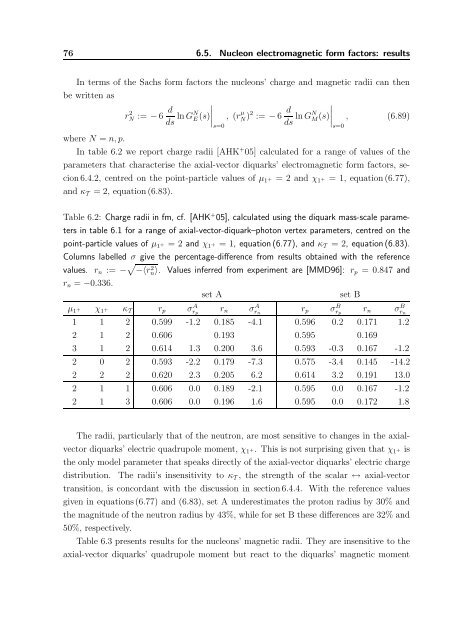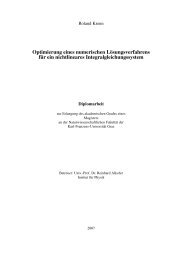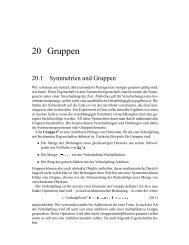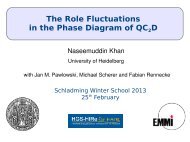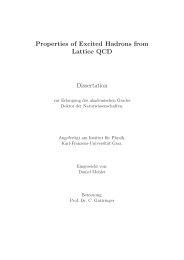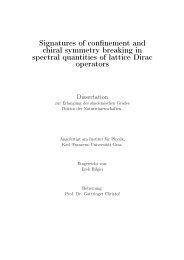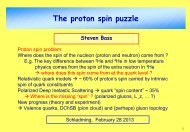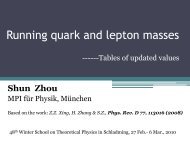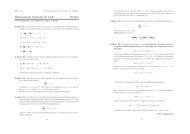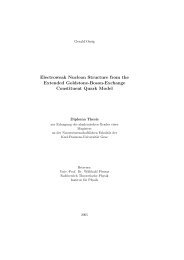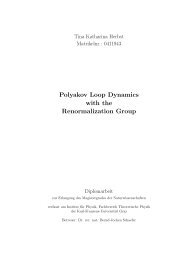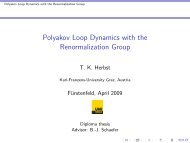The QCD Quark Propagator in Coulomb Gauge and - Institut für Physik
The QCD Quark Propagator in Coulomb Gauge and - Institut für Physik
The QCD Quark Propagator in Coulomb Gauge and - Institut für Physik
You also want an ePaper? Increase the reach of your titles
YUMPU automatically turns print PDFs into web optimized ePapers that Google loves.
76 6.5. Nucleon electromagnetic form factors: results<br />
In terms of the Sachs form factors the nucleons’ charge <strong>and</strong> magnetic radii can then<br />
be written as<br />
rN 2 := − 6 d ∣<br />
∣∣∣s=0<br />
ds ln GN E (s) , (r µ N )2 := − 6 d ∣<br />
∣∣∣s=0<br />
ds ln GN M (s) , (6.89)<br />
where N = n, p.<br />
In table 6.2 we report charge radii [AHK + 05] calculated for a range of values of the<br />
parameters that characterise the axial-vector diquarks’ electromagnetic form factors, secion6.4.2,<br />
centred on the po<strong>in</strong>t-particle values of µ 1 + = 2 <strong>and</strong> χ 1 + = 1, equation(6.77),<br />
<strong>and</strong> κ T = 2, equation(6.83).<br />
Table 6.2: Charge radii <strong>in</strong> fm, cf. [AHK + 05], calculated us<strong>in</strong>g the diquark mass-scale parameters<br />
<strong>in</strong> table 6.1 for a range of axial-vector-diquark–photon vertex parameters, centred on the<br />
po<strong>in</strong>t-particle values of µ 1 + = 2 <strong>and</strong> χ 1 + = 1, equation(6.77), <strong>and</strong> κ T = 2, equation(6.83).<br />
Columns labelled σ give the percentage-difference from results obta<strong>in</strong>ed with the reference<br />
values. r n := − √ −〈r 2 n〉. Values <strong>in</strong>ferred from experiment are [MMD96]: r p = 0.847 <strong>and</strong><br />
r n = −0.336.<br />
set A<br />
set B<br />
µ 1 + χ 1 + κ T r p σr A p<br />
r n σr A n<br />
r p σr B p<br />
r n σr B n<br />
1 1 2 0.599 -1.2 0.185 -4.1 0.596 0.2 0.171 1.2<br />
2 1 2 0.606 0.193 0.595 0.169<br />
3 1 2 0.614 1.3 0.200 3.6 0.593 -0.3 0.167 -1.2<br />
2 0 2 0.593 -2.2 0.179 -7.3 0.575 -3.4 0.145 -14.2<br />
2 2 2 0.620 2.3 0.205 6.2 0.614 3.2 0.191 13.0<br />
2 1 1 0.606 0.0 0.189 -2.1 0.595 0.0 0.167 -1.2<br />
2 1 3 0.606 0.0 0.196 1.6 0.595 0.0 0.172 1.8<br />
<strong>The</strong> radii, particularly that of the neutron, are most sensitive to changes <strong>in</strong> the axialvector<br />
diquarks’ electric quadrupole moment, χ 1 +. This is not surpris<strong>in</strong>g given that χ 1 + is<br />
the only model parameter that speaks directly of the axial-vector diquarks’ electric charge<br />
distribution. <strong>The</strong> radii’s <strong>in</strong>sensitivity to κ T , the strength of the scalar ↔ axial-vector<br />
transition, is concordant with the discussion <strong>in</strong> section6.4.4. With the reference values<br />
given <strong>in</strong> equations(6.77) <strong>and</strong> (6.83), set A underestimates the proton radius by 30% <strong>and</strong><br />
the magnitude of the neutron radius by 43%, while for set B these differences are 32% <strong>and</strong><br />
50%, respectively.<br />
Table 6.3 presents results for the nucleons’ magnetic radii. <strong>The</strong>y are <strong>in</strong>sensitive to the<br />
axial-vector diquarks’ quadrupole moment but react to the diquarks’ magnetic moment


